Physical Address
304 North Cardinal St.
Dorchester Center, MA 02124
Physical Address
304 North Cardinal St.
Dorchester Center, MA 02124
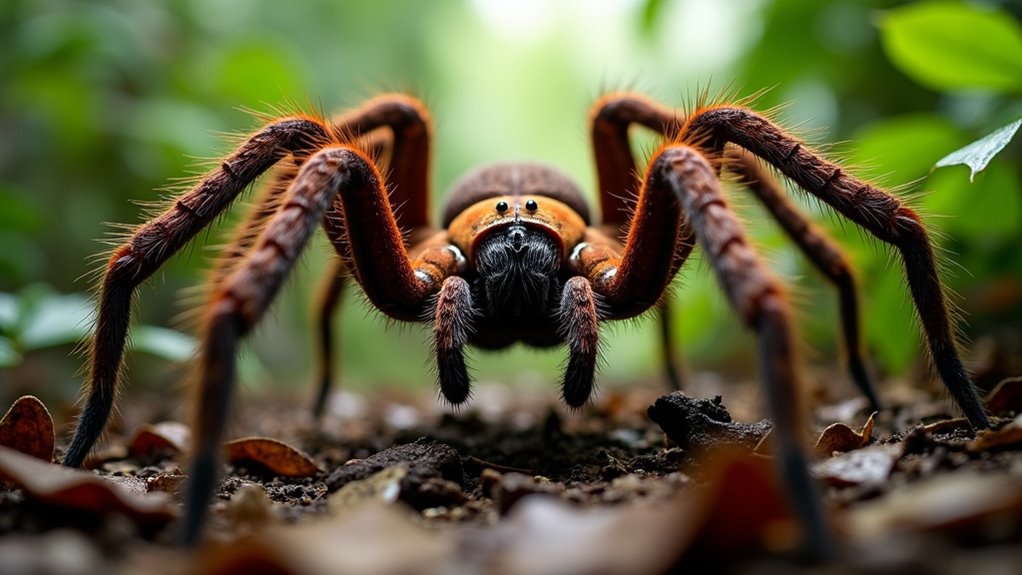
Huge fangs and foot-long legs await as you discover nature's most terrifying eight-legged giants lurking in unexpected places.
The world’s largest spiders include the Goliath Birdeater with its 12-inch leg span, the Giant Huntsman Spider with equal reach but faster movement, and the Brazilian Salmon Pink Birdeater weighing over 100 grams. You’ll also find giants like the Colombian Tarantula, Face-Sized Tarantula, King Baboon Spider, Camel Spider, and deadly Brazilian Wandering Spider. These impressive arachnids showcase nature’s remarkable diversity through their unique hunting strategies and defense mechanisms.
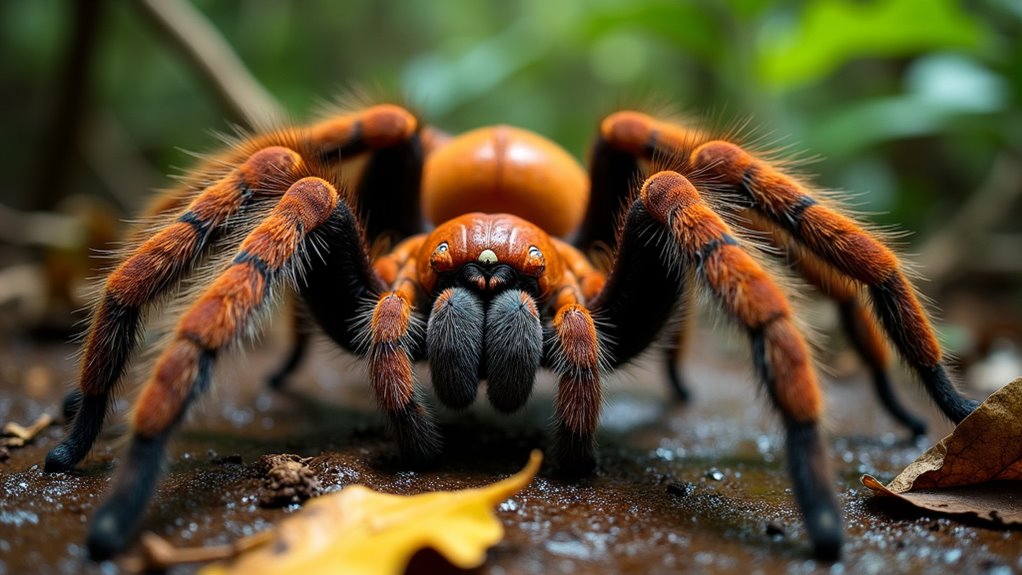
When it comes to arachnid giants, the Goliath Birdeater stands as nature’s undisputed heavyweight champion. This massive tarantula (Theraphosa blondi) tips the scales at up to 6 ounces with a leg span reaching 12 inches.
You’ll find these impressive creatures in northern South America’s rainforests and swamps, where they create deep burrows and hunt at night. Their habitat spans several countries including Brazil, Venezuela, and Guyana, where they prefer marshy environments.
Despite their name, they rarely eat birds, preferring insects, earthworms, and small vertebrates.
Don’t worry if you encounter one—their venom isn’t particularly dangerous to humans, comparable to a bee sting.
However, they’re not defenseless. They’ll release irritating hairs, make intimidating hissing sounds by rubbing their legs together, and rear up to display inch-long fangs when threatened.
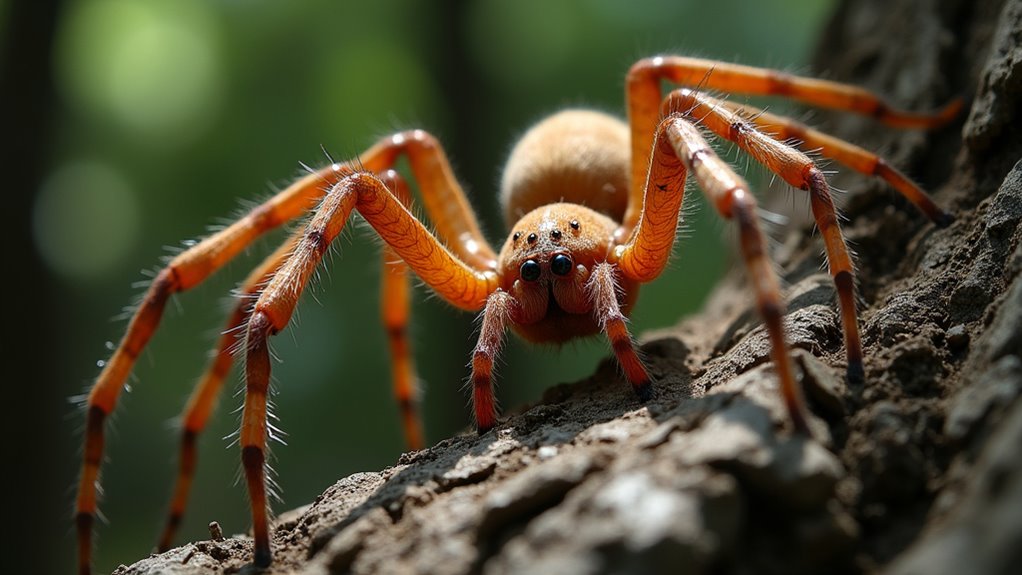
While the Goliath Birdeater may reign as the heaviest spider, the Giant Huntsman Spider (Heteropoda maxima) claims the title for the most impressive leg span in the arachnid world. This cave-dwelling giant from Laos boasts legs stretching up to 12 inches (30 cm) across, with a body length reaching just 1.8 inches (4.6 cm).
While impressive in weight, the Goliath Birdeater falls short against the Giant Huntsman’s spectacular 12-inch leg span.
You’ll be amazed by these record-breaking facts:
This reddish-brown giant remains rarely encountered outside its native limestone caves in Laos. These impressive predators can move remarkably fast, able to travel up to a yard per second when pursuing prey.
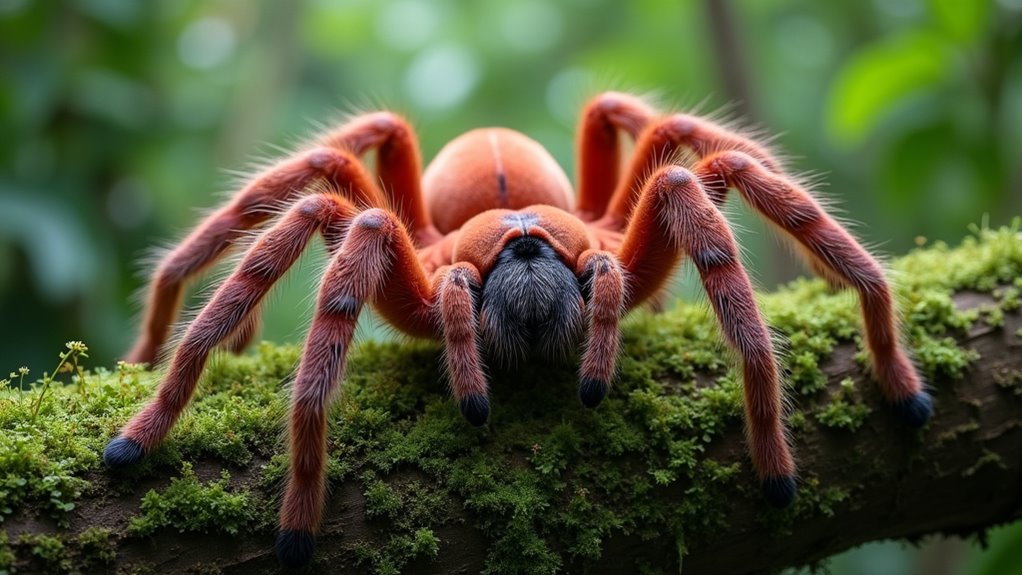
Among the world’s most impressive arachnids, the Brazilian Salmon Pink Birdeater (Lasiodora parahybana) is notable for both its massive size and striking coloration. This tarantula can reach an impressive 11-inch leg span, with females weighing over 100 grams.
Native to northeastern Brazil’s Atlantic Forest, particularly the Paraíba region, these giants thrive in warm, humid environments.
Despite their intimidating name, they don’t regularly consume birds—instead preferring invertebrates and occasionally small vertebrates.
You’ll recognize these spiders by their black base coat adorned with vibrant pink to salmon-colored hairs, more intense in males. The genus name Lasiodora derives from Greek, meaning hairy gift.
First described in 1917, they’ve become popular pets thanks to their impressive appearance and relatively docile nature.
Females can live up to 25 years, while males typically survive only a few years after maturity.
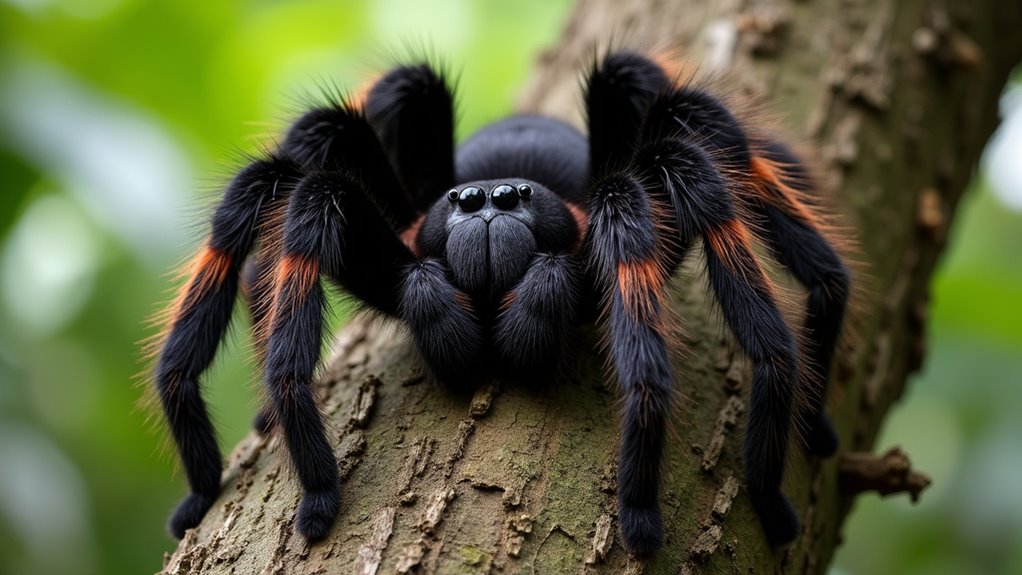
The Colombian Giant Tarantula (Megaphobema robustum) represents another fascinating South American arachnid marvel, though slightly smaller than its Brazilian counterpart. Also known as the Skeleton Tarantula, this species boasts a leg span reaching 7 inches and is easily identified by the striking red coloration on its legs.
You’ll find these terrestrial giants in Colombia’s humid rainforests, where they create deep silk-lined burrows for protection.
While juveniles display confidence, adults generally remain shy until maturity.
When threatened, these impressive arachnids employ a unique defensive technique called the cartwheel of death, twirling in circles to confuse and deter predators.
Three reasons these tarantulas captivate enthusiasts:
With proper care in warm, humid environments, these nocturnal hunters can live 10-12 years in captivity.
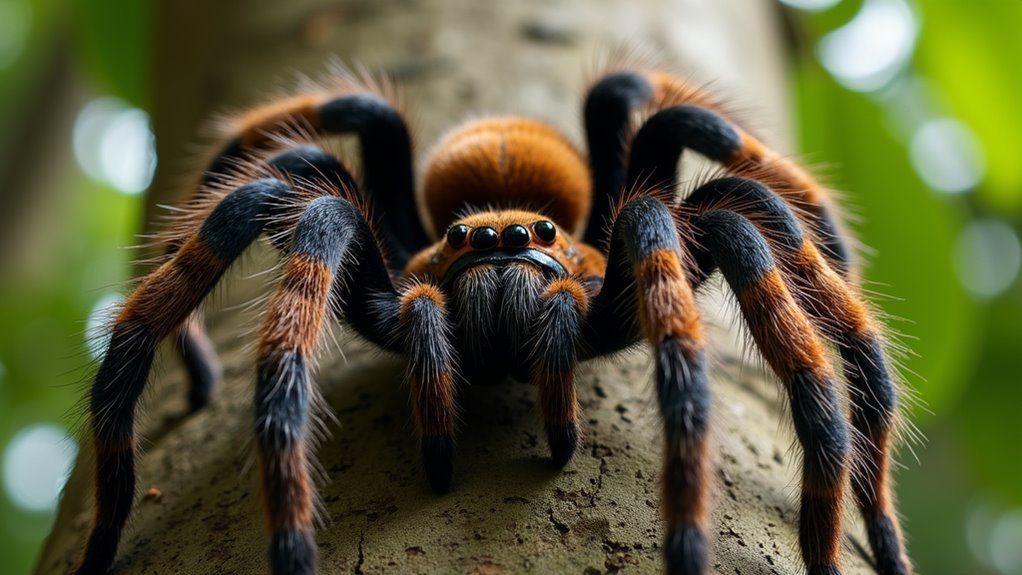
First discovered in 2009, the face-sized tarantula (Poecilotheria rajaei) earned its intimidating name from its massive leg span stretching up to 8 inches across—roughly the size of a human face. This ornamental tiger spider is distinguished by its vibrant coloration, including a distinctive pink abdominal band.
Native to northern Sri Lanka, you’ll find these arachnids primarily in well-established old trees with natural hollows. The species was formally described in 2012 and named after police inspector Michael Rajakumar Purajah who assisted researchers during their arachnid survey.
Unfortunately, they’re likely critically endangered due to rampant deforestation. As their natural habitats disappear, they’ve been forced into human settlements, including buildings and hospitals.
While venomous, they aren’t lethal to humans. However, fear often drives locals to kill them on sight.
These impressive predators play a crucial role in controlling insect populations, making their conservation essential for maintaining Sri Lanka’s unique biodiversity.
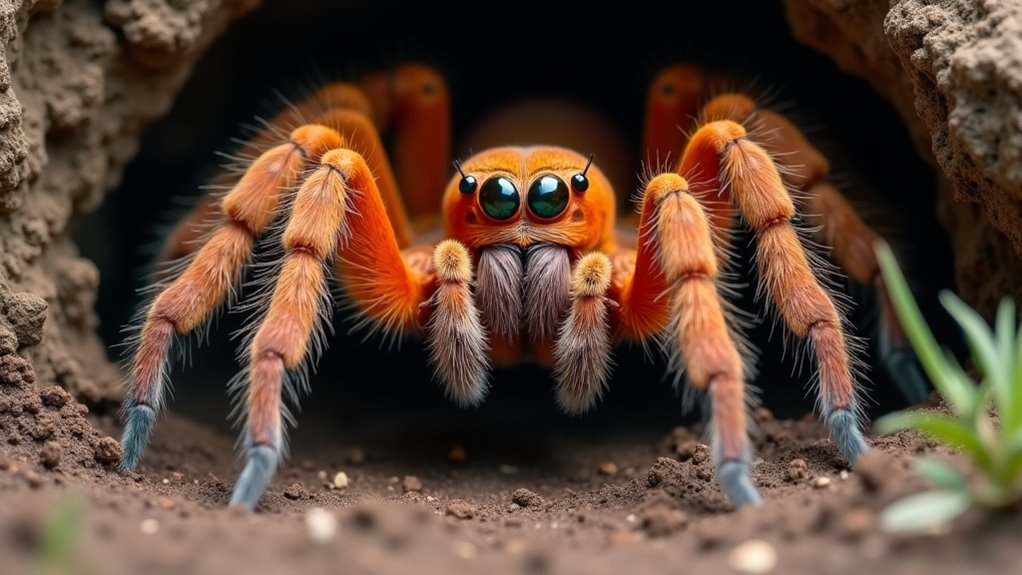
Africa’s largest terrestrial tarantula, the King Baboon Spider (Pelinobius muticus), commands respect with its imposing 8-inch leg span and rusty brown to orange coloration.
You’ll find these giants burrowing in the scrublands and grasslands of Kenya and Tanzania, where they create underground homes protected by vegetation.
If you’re considering one as a pet, be warned:
This monotypic genus is only recommended for experienced owners due to its defensive nature and specific care requirements. Their bites, while not deadly, can cause sharp pain and itchiness that may persist for up to five days.
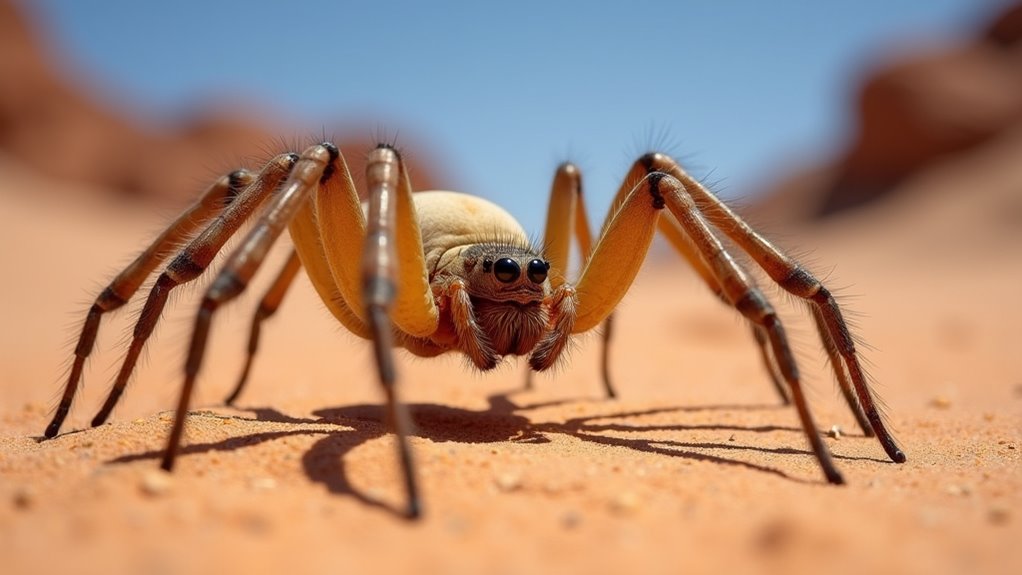
Despite their intimidating reputation, camel spiders aren’t actually spiders at all but belong to the order Solifugae, a distinct group of arachnids with over 1,000 described species. These misunderstood creatures can reach impressive sizes of up to 6 inches in length, sporting large jaw-like chelicerae that they use to crush their prey.
You’ll find these tan or brown hunters in desert ecosystems worldwide, where they play vital roles as predators. Their body consists of two main segments—the prosoma and opisthosoma—without the connecting pedicel seen in true spiders. Their name comes from Latin, sol fugere meaning “those who flee from the sun,” reflecting their nocturnal habits and tendency to seek shade during daylight hours.
While they’re aggressive hunters of insects and other small arthropods, they pose no venomous threat to humans. Unfortunately, their fragile desert habitats face increasing threats from human activities, making research on these elusive predators challenging.

Known for both their deadly venom and impressive size, Brazilian Wandering Spiders belong to the genus Phoneutria, which fittingly means “murderess” in Greek. These nocturnal hunters roam forest floors throughout South America, occasionally hitching rides to North America and Europe in banana shipments.
While you might mistake them for harmless banana spiders, these arachnids pack serious danger:
Don’t be fooled by appearances—these wandering arachnids deliver potent venom with an aggressive temperament to match.
During daylight hours, you’ll find them hiding in logs or crevices, waiting for darkness to resume their deadly prowl. When threatened, they assume a characteristic defensive posture by standing on their hind legs and exposing their fangs, making them appear even more intimidating.
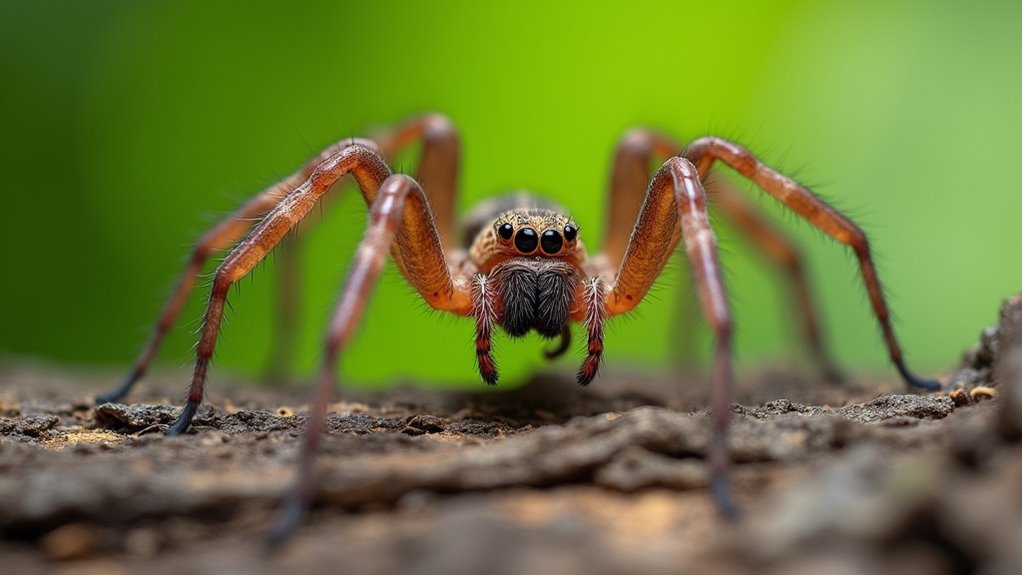
When you encounter a huntsman spider racing across your wall at surprising speeds, you’re witnessing one of nature’s most impressive arachnid athletes. These large, crab-like spiders can reach leg spans of up to 15 cm, with flattened bodies designed to slip into narrow crevices.
Unlike web-builders, huntsman spiders actively hunt their prey, using venom to immobilize insects and occasionally small vertebrates. While they might look intimidating with their grey to brown bodies and banded legs, they’re typically not aggressive toward humans. Males can produce substrate-borne vibrations as a form of sound during mating rituals to attract females.
Found primarily in Australia and Southeast Asia, huntsman spiders prefer caves, rock crevices, and areas near human dwellings.
Females fiercely protect their egg sacs containing up to 200 eggs, sometimes even consuming males after mating.
Despite their fearsome appearance, they’re valuable controllers of insect populations.
These nine giants of the spider world show just how diverse arachnids can be. Like an NBA basketball player towering over average humans, the Goliath Birdeater dwarfs common house spiders by over 1000 times in weight. You’ll find these impressive creatures on every continent except Antarctica. While their size might trigger your arachnophobia, remember that they’re essential predators keeping insect populations in check within their ecosystems.